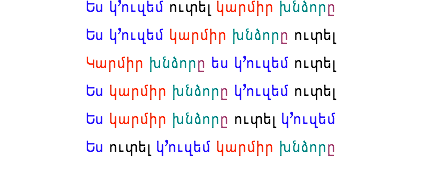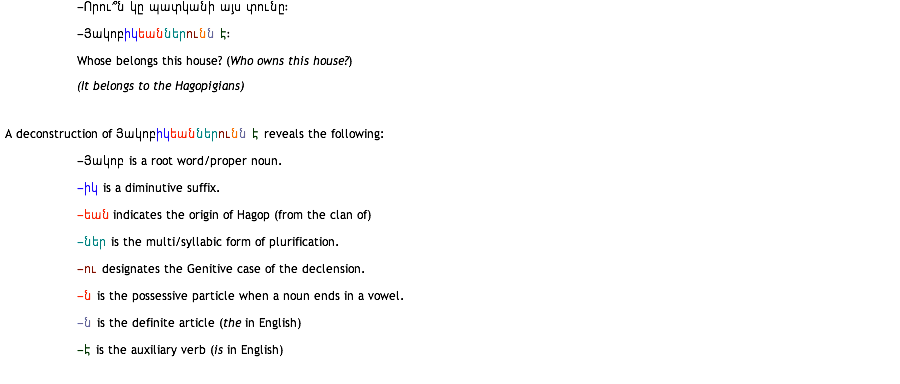MORPHOLOGY OF ARMENIAN
LANGUAGE
In general, the morphology (syntax
or
linguistic typology)
of a language is similar to a road map. Syntax
and Linguistic Typology provide the basis of
the combinatory behavior of words that are
governed to a first approximation by
their
part of speech
(nouns, verbs, adjectives, etc.), a
categorization that goes back to the tradition
of the Greek grammarian Dionysios of Thrax
whose works were already well known in the
Armenian highland as of first century BC.
This overview is intended as an introduction in
order to underline the particularities of the
language and highlight the importance of the
inflections in Armenian grammar (declension of
the nouns, conjugation of the verbs, etc.).
A. Syntax
In linguistics,
Syntax
(Greek,
syn,
with +
taxis,
arrangement) is the part of grammar which deals
with the order, arrangement, and the relations
of the words in a sentence or a phrase.
Although modern linguistic research into
natural syntax attempts to systematize
descriptive grammar, Armenian syntax defies the
many theories (theories that have in time risen
or fallen in influence) of
formal syntax.
A modern approach to combining accurate
descriptions of the grammatical patterns of a
language with their function in context is that
of
systemic functional
grammar,
an approach originally developed by Michael
A.K. Halliday in the 1960s and now pursued
actively by linguists on all continents.
"Colorless
green ideas sleep
furiously"
is a phrase composed by Noam Chomsky in 1957 as
an example of a sentence that is grammatically
correct in terms of
syntax
but whose meaning is nonsensical. However, this
phrase was used by Chomsky to demonstrate the
inadequacy of the then-popular probabilistic
models of grammar, and the need for more
structured models.
We can almost state with a certain degree of
certitude that Armenian language is not
concerned with the grammatical debate on Syntax
or the formulation of the different theories on
the subject since the well structured
inflections of the words in Armenian grammar
provide a flexibility that endows the language
with a depth of expression that is not
restrained by the grammatical rules or
principles of syntax and the variations in an
Armenian phrase are often a matter of emphasis
on one of the elements in a phrase (i.e., the
action/verb, the subject of the verb or its
object) or style of writing rather than a
grammatical imperative.
Although it is tempting to use the phrase by
Chomsky "Colorless
green ideas sleep
furiously"
as an example to underline the flexibility of
an Armenian phrase, it may be more appropriate
perhaps to use a common and “sensical” phrase:
I want
to eat
the
red
apple
Without the addition of any other words to the
English language phrase, there is only one
grammatically accurate way to express the
desire of wanting to eat a red apple. Yet, if
one is to assign the task of translating this
expression into a grammatically correct
Armenian, we may end up having the following
choices:

It has to be noted that all the expressions in
the Armenian sentences are grammatically
accurate and no poetic license is applied in
their composition. Obviously, there are perfect
grammatical explanations to elucidate the
flexibility of the Armenian syntax. To cite
just a few:
1- The distinctive ending of each case of the
conjugation of the verbs in Armenian allows the
separation of the stem of the verb from the
subject and the insertion of other parts of the
components of the phrase between the
subject
and the
verb.
while it is not possible to do so in English.
2- The
Accusative
case of the word
apple
offers the possibility of placing this word
almost anywhere in the phrase since the
case of the declension
clearly defines the role of the word as the
object of the verb.
3- It is also possible to reverse the order
of
I want to eat
(I to eat want) in Armenian since there is no
grammatical obstacle to do so. The permutation
of the conjugated part of the verbs (I want)
and the infinite form (to eat) are not
restrained by any rule of syntax or grammar.
B. Typology of Armenian
Phrases:
Armenian is considered an SOV type language. In
other words,
Subject-Object-Verb
(SOV) is the type of languages in which
the
subject,
object,
and
verb
of a sentence appear (usually) in that order:

If English were SOV, then "The swallow nest
builds" would be an ordinary sentence. However,
there is nothing dogmatic about this rule. It
is also accurate to reformulate this sentence
and write:

Yet, it is accurate to state that Armenian is
SOV type language since this type of languages
have also other characteristics that
distinguish them from members of other
families:
1- SOV languages have a strong tendency to
use
postpositions
rather than prepositions.
2-
To place
genitive nouns*
before the possessed noun:
3-
Within Eurasian SOV languages, adjectives are
often placed before the nouns they modify:
C.
Agglutination:
An
agglutinative language
is a language in which derivative words are
formed by joining morphemes together. This term
was introduced by W. von Humboldt in 1836 to
classify languages from a morphological point
of view. The word agglutinative is derived from
the Latin verb
agglutinare,
which means "to
glue together."
An agglutinative language is a form of language
where each affix (prefix or suffix) typically
represents one unit of meaning (such as
"diminutive," "past tense," "plural," etc.),
and bound morphemes are expressed by affixes
(and not by internal changes of the root of the
word, or changes in stress or tone). Besides,
and most importantly, in an agglutinative
language affixes do not become fused with
others, and do not change form conditioned by
others.
Agglutinative languages tend to have a high
rate of affixes/morphemes per word, and to be
very regular. For example, Japanese has only
three irregular verbs (and not
very
irregular), Nahuatl only two. Armenian is an
exception; not only because it is highly
agglutinative (there can be simultaneously up
to 8 morphemes per word), but there are also a
significant number of irregular verbs, varying
in degrees of irregularity.
An example of an agglutinative word can be the
following dialogue:

* * * * * * *
After reviewing some of the morphological
basics of Armenian grammar, it is perhaps
important to note that none of the
characteristics described above bear any hints
of influence from Classical Greek or Old
Persian grammar. Amazingly, these
characteristics reflect many of the features of
the extinct languages that were spoken within
the region, until recently known as the
Armenian Plateau (currently designated as
Anatolia) and its immediate surroundings.
The
Hurro-Urartian languages
(circa 2000-580 BC) were agglutinative
languages, but they definitely did not belong
to the Semitic or Indo-European language
families. Scholars such as I.M. Diakanoff and
Segei Starostin see affinities between
Hurro-Urartian and the Northern Caucasian
languages, yet, there is little evidence for a
relationship of Hurro-Urartian to other
language families and this view, prudently, is
not shared by serious linguists who consider
Hurro-Urartian as an independent family at
present.
Today, studies demonstrate that there is
evidence of a strong Hurrian cultural and
linguistic influence on
Hittite
in ancient times. Consequently, one can easily
conclude that together with
Summerian, Elamite, Hattic
or
Urartian
languages, Armenian grammar inherited some its
grammatical and lexical elements from the
languages that have seen their political and
military rise and fall throughout the ages.
Astoundingly, Armenian language seems to be the
only survivor as well as the only link to these
extinct languages and civilizations.